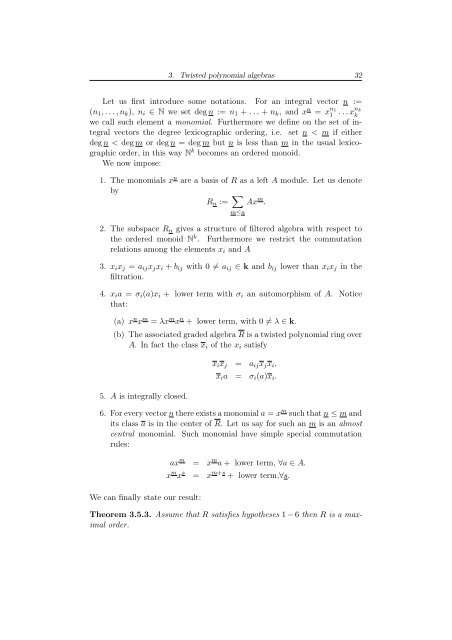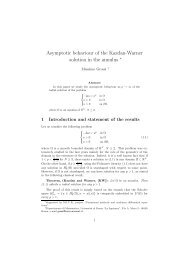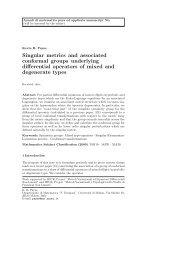Degree of Parabolic Quantum Groups - Dipartimento di Matematica ...
Degree of Parabolic Quantum Groups - Dipartimento di Matematica ...
Degree of Parabolic Quantum Groups - Dipartimento di Matematica ...
Create successful ePaper yourself
Turn your PDF publications into a flip-book with our unique Google optimized e-Paper software.
3. Twisted polynomial algebras 32<br />
Let us first introduce some notations. For an integral vector n :=<br />
(n1, . . .,nk), ni ∈ N we set deg n := n1 + . . . + nk, and xn = x n1<br />
1 . . .xnk k<br />
we call such element a monomial. Furthermore we define on the set <strong>of</strong> integral<br />
vectors the degree lexicographic ordering, i.e. set n < m if either<br />
deg n < deg m or deg n = deg m but n is less than m in the usual lexicographic<br />
order, in this way Nk becomes an ordered monoid.<br />
We now impose:<br />
1. The monomials xn are a basis <strong>of</strong> R as a left A module. Let us denote<br />
by<br />
Rn := <br />
Ax m .<br />
m≤n<br />
2. The subspace Rn gives a structure <strong>of</strong> filtered algebra with respect to<br />
the ordered monoid N k . Furthermore we restrict the commutation<br />
relations among the elements xi and A<br />
3. xixj = aijxjxi + bij with 0 = aij ∈ k and bij lower than xixj in the<br />
filtration.<br />
4. xia = σi(a)xi + lower term with σi an automorphism <strong>of</strong> A. Notice<br />
that:<br />
(a) x n x m = λx m x n + lower term, with 0 = λ ∈ k.<br />
(b) The associated graded algebra R is a twisted polynomial ring over<br />
A. In fact the class xi <strong>of</strong> the xi satisfy<br />
5. A is integrally closed.<br />
xixj = aijxjxi,<br />
xia = σi(a)xi.<br />
6. For every vector n there exists a monomial a = x m such that n ≤ m and<br />
its class a is in the center <strong>of</strong> R. Let us say for such an m is an almost<br />
central monomial. Such monomial have simple special commutation<br />
rules:<br />
We can finally state our result:<br />
ax m = x m a + lower term, ∀a ∈ A.<br />
x m x s = x m+s + lower term,∀s.<br />
Theorem 3.5.3. Assume that R satisfies hypotheses 1 −6 then R is a maximal<br />
order.








